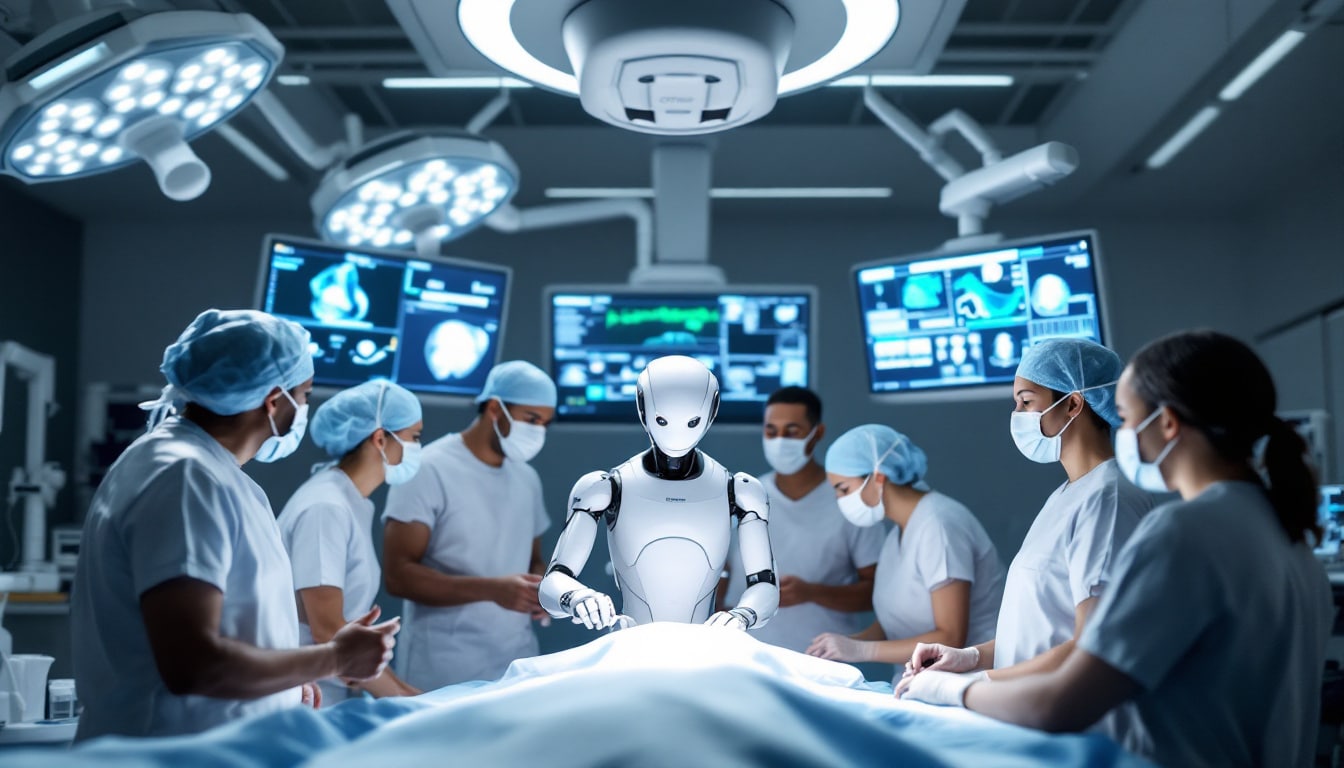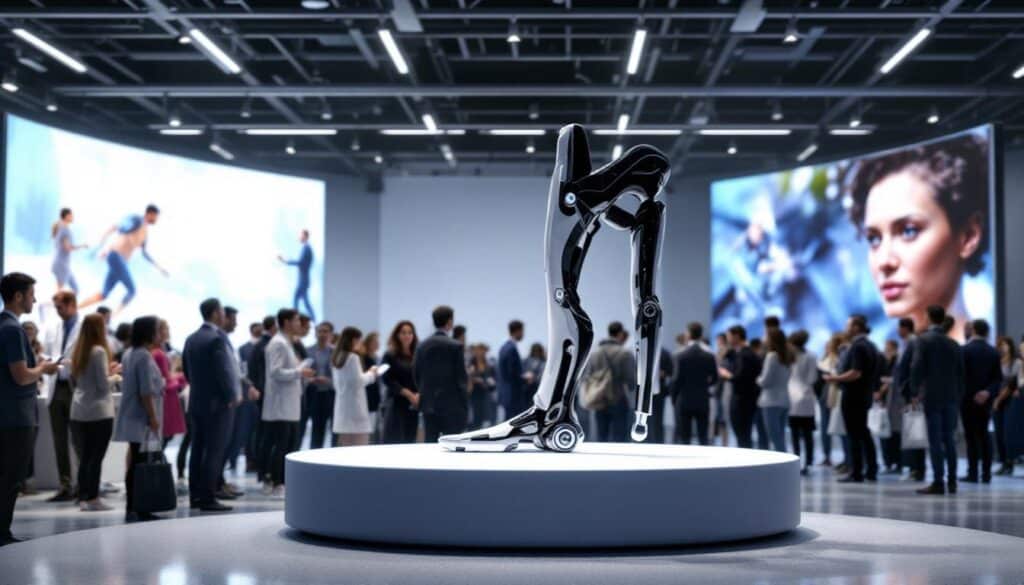The technological revolution is making its way into operating rooms. Johnson & Johnson MedTech has achieved a major milestone with its surgical robot Ottava. The first clinical interventions show immense potential.
This development marks a significant advance in the field of minimally invasive surgery. Dr. Erik Wilson, a specialist in general and minimally invasive surgery at UT Health Houston, performed a Roux-en-Y surgery using the Ottava robot at Memorial Hermann-Texas Medical Center. According to him, surgical robotics is at the forefront of medical innovation, and the use of Ottava could redefine current standards. This multi-specialty robot is designed to facilitate various procedures by adapting to different anatomies and surgical specialties. Johnson & Johnson MedTech’s goal is to remove barriers to mobility and collaboration in robotic operating rooms. Ottava gives surgical teams the freedom to customize their approaches according to the individual needs of patients. The company plans to use the data collected during this clinical evaluation to demonstrate the system’s versatility and obtain FDA approval for multiple procedures in general surgery of the upper abdomen.
Hani Abouhalka, head of the surgery group at Johnson & Johnson MedTech, emphasized the importance of this innovation in their technology portfolio. Ottava stands out for its unified architecture, allowing for a discreet design with its robotic arms integrated under the operating table when not in use. This system aims to support complex surgeries requiring a multi-quadrant approach. Since its initial launch over four years ago, Ottava has undergone several evolutions to optimize its performance and integration in clinical settings.
The collaboration between Johnson & Johnson MedTech and surgical teams around the world plays a crucial role in improving patient care. Dr. Peter Schulam, scientific director, stated that generating clinical evidence is at the heart of their innovation programs, aiming to advance robot-assisted surgery. This study marks a key step in the quest for higher standards in surgical care, promising a future where technology and medicine join forces to offer more precise and personalized treatments.
#>

Johnson & Johnson MedTech achieves first interventions with the Ottava surgical robot
In a significant step toward the future of surgery, Johnson & Johnson MedTech recently announced the success of the first clinical interventions using its surgical robot Ottava. These initial operations, performed by Dr. Erik Wilson at Memorial Hermann-Texas Medical Center, mark a crucial milestone in the integration of advanced robotic technologies into modern surgical practices.
What does the Ottava surgical robot bring new?
The surgical robot Ottava is distinguished by its innovative architecture and versatility. Designed to support a wide range of surgical procedures, Ottava is equipped with four robotic arms integrated into a standard-sized operating table. This design allows for smooth navigation and enhanced collaboration within the operating room, thereby meeting the diverse needs of surgeons and patients.
Unlike traditional surgical robots, Ottava is designed to be discreet when not in use, with robotic arms concealed under the surgical table. This flexibility allows surgical teams to easily adapt to clinical workflows while maintaining an orderly and efficient operating environment. To learn more about innovations in surgical robotics, you can consult our detailed report.
What were the first interventions performed with Ottava?
The first clinical interventions performed with Ottava included a Roux-en-Y gastric bypass surgery. Conducted by Dr. Erik Wilson, head of minimally invasive and elective general surgery at UT Health Houston, this procedure demonstrated the precision and effectiveness of the robot in complex interventions. The success of these initial cases paves the way for broader adoption of Ottava in various surgical fields.
These initial interventions have provided crucial data on the robot’s performance, including its ability to support multi-quadrant surgeries and adapt to different patient anatomies. The positive results from these first operations attest to Ottava’s potential to revolutionize minimally invasive surgery.
How does Johnson & Johnson MedTech envision the future of Ottava?
Johnson & Johnson MedTech plans to use the data collected during the clinical evaluation of Ottava to enhance the system’s capacity to perform a variety of procedures. After the completion of this study, the company aims to submit the robot to the FDA for a de novo classification, targeting an indication covering multiple procedures in general surgery of the upper abdomen, such as sleeve gastrectomy, small intestine resection, and hiatal hernia repair.
According to Hani Abouhalka, president of the surgery group at Johnson & Johnson MedTech, Ottava represents a key innovation in the company’s advanced technology portfolio. “Our technologies are designed to transform surgical experiences at all levels. Ottava is a major step in our mission to improve patient care and set new standards in robotic surgery.”
What are the clinical benefits of Ottava for surgeons and patients?
The introduction of Ottava in operating rooms offers numerous advantages for both surgeons and patients. For surgeons, Ottava provides increased precision and better visualization of surgical areas through its sophisticated robotic arms and integrated tools. This technology reduces surgical fatigue and allows for longer and more complex interventions with improved efficiency.
For patients, the benefits translate into shorter recovery times, smaller incisions, and a reduced risk of postoperative complications. The minimally invasive nature of procedures performed with Ottava also contributes to less pain and discomfort after surgery, thereby improving the overall patient experience.
What are the next steps for Ottava and J&J MedTech?
Following the success of the first interventions, Johnson & Johnson MedTech plans to expand the use of Ottava to other types of surgeries. The goal is to position Ottava as an essential tool in operating rooms, capable of adapting to a multitude of procedures and meeting the specific needs of each patient.
Additionally, the company continues to invest in research and development to enhance Ottava’s capabilities and explore new clinical applications. These efforts are part of a broader initiative towards innovations in MedTech aimed at pushing the boundaries of medical technology and offering cutting-edge solutions to healthcare professionals.
How does Ottava fit into the current technological landscape?
In a context where surgical robotics is increasingly competitive, Ottava stands out for its ability to seamlessly integrate technology into existing clinical workflows. The flexibility and ease of use of Ottava allow for rapid adoption by surgical teams while delivering superior performance compared to currently available robotic solutions.
Moreover, Johnson & Johnson MedTech benefits from its reputation and expertise in medical technology to ensure the quality and reliability of Ottava. The company’s commitment to innovation continues to strengthen its position as a leader in the field of surgical robotics, supported by initiatives such as specialized conferences that highlight the latest advances from J&J MedTech.
What is the potential impact of Ottava on the healthcare sector?
The introduction of Ottava has the potential to significantly transform the healthcare sector by improving the precision of surgical interventions and optimizing outcomes for patients. By reducing surgical times and decreasing risks associated with invasive procedures, Ottava can contribute to better management of hospital resources and a reduction in healthcare costs over the long term.
Additionally, Ottava’s versatility allows its use in various surgical fields, thereby facilitating a multidisciplinary and integrated approach to care. This capacity to adapt to different medical specialties encourages increased collaboration among healthcare professionals, thereby enhancing the quality of care provided and the effectiveness of treatments.
For more information on technological challenges and innovations in surgical robotics, feel free to consult our specialized report.
What are the testimonials from Ottava users?
The initial feedback from surgeons using Ottava is extremely positive. Dr. Erik Wilson expressed his pride in conducting the first clinical studies with the robot, stating that “surgical robotics is at the forefront of innovation in minimally invasive surgery. Ottava allows us to push the limits of what is possible and improve care standards for our patients.”
These testimonials highlight the importance of collaboration between technology developers and healthcare professionals. By working closely with surgeons, Johnson & Johnson MedTech ensures that robotic solutions meet the real-world needs and effectively contribute to the improvement of surgical practices.
What are the future perspectives for surgical robotics?
With the successful launch of Ottava, the prospects for surgical robotics are promising. Ongoing innovation and technological advancements in this field pave the way for safer, faster, and less invasive procedures. The ability of robots like Ottava to adapt to various surgical interventions and seamlessly integrate into existing workflows is crucial for their widespread adoption.
Moreover, the rise of telemedicine and connected technologies offers new opportunities for the integration of surgical robots into broader and more diverse clinical environments. Future developments could include better artificial intelligence, allowing robots to provide even more personalized and adaptive support to surgeons, thus improving outcomes for patients.
In parallel, initiatives such as Neuralink projects demonstrate the medical industry’s capability to explore cutting-edge technologies to transform healthcare. These collective efforts contribute to creating an ecosystem where innovation and medical excellence go hand in hand.
How does Johnson & Johnson MedTech position itself in the global surgical robotics market?
In the global surgical robotics market, Johnson & Johnson MedTech positions itself as a key player thanks to its continuous innovations and ability to meet the changing needs of healthcare professionals. With the introduction of Ottava, the company strengthens its presence in a sector dominated by established players such as Intuitive Surgical.
The strategy of J&J MedTech relies on the integration of advanced technologies, collaboration with clinical experts, and rapid adaptation to regulatory requirements. These elements enable the company to differentiate itself and offer robotic solutions that directly address the challenges faced in modern operating rooms.
To keep up with the latest news and innovations from Johnson & Johnson MedTech, check out our weekly summary and stay informed about future developments in the MedTech field.
What are the upcoming challenges for Ottava and surgical robotics?
Despite promising advances, the widespread adoption of surgical robots like Ottava presents several challenges. One of the main obstacles is the high initial cost of robotic technologies, which can limit their accessibility, especially in resource-limited healthcare facilities.
Furthermore, training for surgeons and medical personnel in the effective use of these robots is essential to ensure optimal outcomes. Johnson & Johnson MedTech is committed to providing comprehensive training programs and ongoing support to facilitate the integration of Ottava into daily surgical practices.
Technological challenges, such as improving artificial intelligence and reducing the complexity of robotic systems, are also at the heart of future development efforts. By working closely with the medical community and regulators, J&J MedTech aims to overcome these obstacles and continue to push the boundaries of robotic surgery.
For an in-depth analysis of the technological challenges faced by surgical robots, consult our specialized report.
How do innovations like Ottava influence medical training?
The introduction of advanced surgical robots like Ottava also revolutionizes the training of future surgeons. Educational programs must now incorporate training in surgical robotics, providing students and practicing practitioners with the skills necessary to fully utilize these technologies.
Johnson & Johnson MedTech plays an active role in this area by collaborating with academic institutions and training centers to develop educational modules specific to the use of Ottava. This approach ensures that new generations of surgeons are well-equipped to effectively use surgical robots, thereby improving the quality of care and outcomes for patients.
Additionally, the conferences and seminars organized by the company, such as those presented by Ibraheem Badejo PhD, offer valuable opportunities for healthcare professionals to stay updated on the latest innovations and best practices in surgical robotics.
What are the strategic partnerships of Johnson & Johnson MedTech for Ottava?
To ensure the success and adoption of Ottava, Johnson & Johnson MedTech has established several strategic partnerships with healthcare institutions, universities, and leading technology companies. These collaborations leverage complementary expertise and co-develop innovative solutions tailored to clinical needs.
A notable example is the collaboration with UT Health Houston, where Dr. Erik Wilson conducted the first clinical interventions with Ottava. This alliance allows for direct feedback from practitioners and continuously refines the robot’s functionalities to better meet field requirements.
Moreover, Johnson & Johnson MedTech actively participates in global initiatives such as Invest Pitch Perfect for devices and diagnostics, aimed at promoting innovation and identifying the most promising technologies in the MedTech field. These partnerships strengthen J&J MedTech’s position as a leader in medical innovation.
What are the economic impacts of Ottava on the healthcare sector?
The introduction of Ottava brings not only clinical improvements but also significant economic benefits for the healthcare sector. By reducing intervention times and optimizing operational resources, Ottava contributes to a more efficient use of surgeons’ and medical personnel’s time, which could result in an increase in the number of procedures performed per day.
Moreover, the benefits in terms of faster postoperative recovery and reduced complications could lead to a decrease in costs related to postoperative care and hospital stays. These potential savings reinforce the economic argument for investing in advanced robotic technologies like Ottava.
For a detailed analysis of the economic implications of new medical technologies, consult our weekly summary.
What is the market’s reception of Ottava?
The medical market has enthusiastically welcomed the launch of Ottava, recognizing its potential to transform surgical practices. Hospitals and clinics are particularly interested in Ottava’s ability to adapt to various types of procedures and offer unparalleled flexibility in operating rooms.
Analysts in the MedTech sector estimate that Ottava could well position itself as a competitive alternative to existing robotic solutions, thanks to its innovative features and user-centered approach. This positive perception is reinforced by the promising initial clinical results and Johnson & Johnson MedTech’s ongoing support for improving and extending the robot’s capabilities.
Furthermore, J&J MedTech’s active presence at key events and specialized conferences contributes to increasing Ottava’s visibility and stimulating interest among healthcare professionals worldwide. These marketing and communication efforts play a crucial role in the rapid adoption of Ottava in the global market.
How does Ottava fit into Johnson & Johnson’s overall strategy?
The launch of Ottava is perfectly aligned with Johnson & Johnson’s overall strategy to strengthen its position in the field of medical technology. By investing in advanced robotic innovations, J&J MedTech demonstrates its commitment to the continuous improvement of healthcare and the transformation of surgical practices.
This initiative aligns with the company’s strategic goals aiming to merge biology and technology to create integrated and innovative health solutions. The emphasis on surgical robotics with Ottava also reflects J&J MedTech’s willingness to stay at the forefront of technological advancements and to meet the changing needs of healthcare professionals and patients.
To further explore the innovations and strategies of Johnson & Johnson MedTech, you can read our series of conferences that detail the company’s recent advancements.
🔬 Ce robot chirurgical est composé de 4 bras articulés, pilotés à distance par un chirurgien qui a une vision 3D très précise. Cela se rapproche d'une opération à l’aide d’une caméra dans le thorax, mais moins douloureuse car l’articulation des instruments est moins rigide. Ce… pic.twitter.com/FAhd3gwkb5
— Département de la Sarthe (@sarthefr) November 29, 2024













